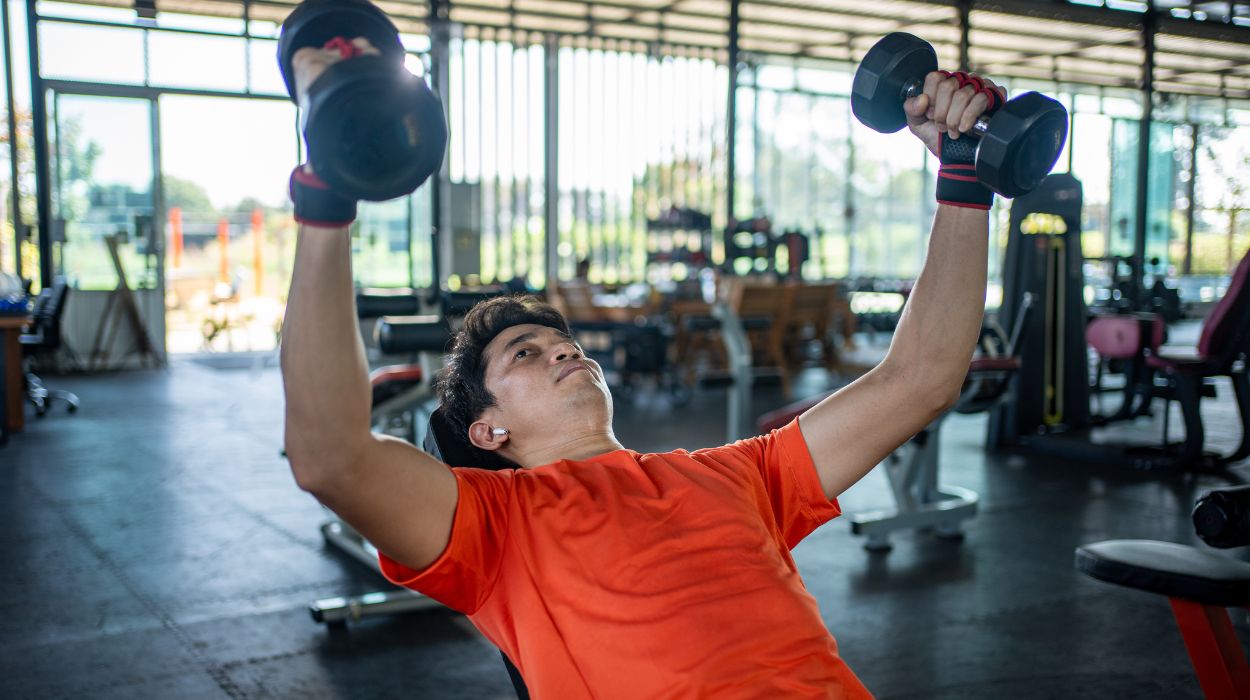
An overhead press, like the bench press, is a compound exercise. This means that it incorporates more than one muscle group to initiate movement. While a bench press focuses on the triceps and chest, an overhead press targets the shoulders.
But, due to personal preferences or other reasons, you may choose alternatives to the overhead press. These alternatives range from body weight to cable dynamics and kettlebell swings.
More importantly, a fit year is possible if you implement these alternative exercises. Do this while prioritizing your goals. Consistency is also more important than how heavy the weight is or how many sets per workout.
If you want to include any overhead press alternative in your workout regimen, then you are in the right place. It is time to dive in.
10 Best Alternatives For Overhead Press
- Seated Dumbbell Shoulder Press.
- Resistance Band Rear Flyes.
- Standing Dumbbell Lateral Raises.
- Standing Dumbbell Front Raises.
- Standing EZ Bar Upright Rows.
- Seated Machine Lateral Raises.
- Standing Plate Front Raises.
- Standing Cable Rear Delt Flyes.
- Seated Dumbbell Arnold Press.
- Standing Kettlebell Swings.
These 10 overhead press alternatives strengthen the shoulders and supporting muscles. Many can be done at home or the gym, making them a versatile option.
10 Best Alternatives To Overhead Press
The following exercises are the best alternatives to overhead press in 2024.
Seated Dumbbell Shoulder Press
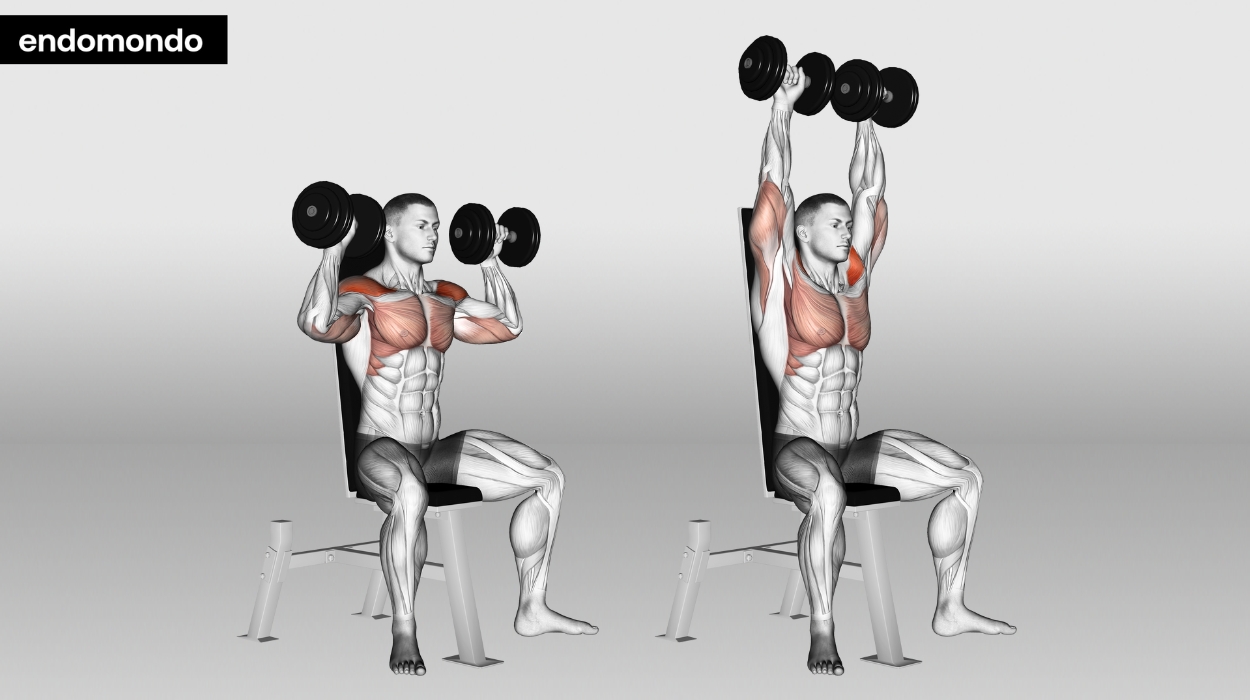
The seated dumbbell shoulder press is a compound exercise that primarily works on the deltoid muscles.[1] This is a deep shoulder muscle that supports shoulder motion and stability.
The benefits of this exercise make it an indispensable tool for upper-body strength training. They include the following:
- It shapes well-rounded shoulders by increasing size and strength in the anterior, medial, and posterior deltoid heads.
- This exercise strengthens the midsection by requiring core stability throughout the exercise.
- Dumbbell presses provide a more natural shoulder path than barbell overhead presses; this could lessen joint stress, reducing the risk of injuries.
How to do:
- Sit on a bench with the backrest upright at 80 to 90 degrees. Keep your back straight and engage your core. Using a neutral grip, hold a dumbbell in each hand with the palms facing each other. Place the dumbbell on your thighs to begin. Squeeze your shoulder blades together for maximum contraction as you lift the dumbbells to shoulder level.
- Extend your arms and press the dumbbells overhead.
- Return the dumbbells to the initial position gradually while maintaining control.
- Repeat this movement for the desired number of repetitions.
Tips:
- Keep your back straight and engage your core.
- Choose dumbbells that will enable you to complete eight to 12 repetitions with controlled movements and appropriate technique.
- Inhale as you bring the dumbbells down, and exhale as you raise them.
- Perform warm-up exercises to prevent injury.
- Stop if you feel pain at any point and seek professional help from health personnel.
Optimal Sets And Reps: The optimal sets and reps depend on your fitness goals and capacity. However, you can adopt three to five sets of eight to 12 repetitions.
Resistance Band Rear Fly
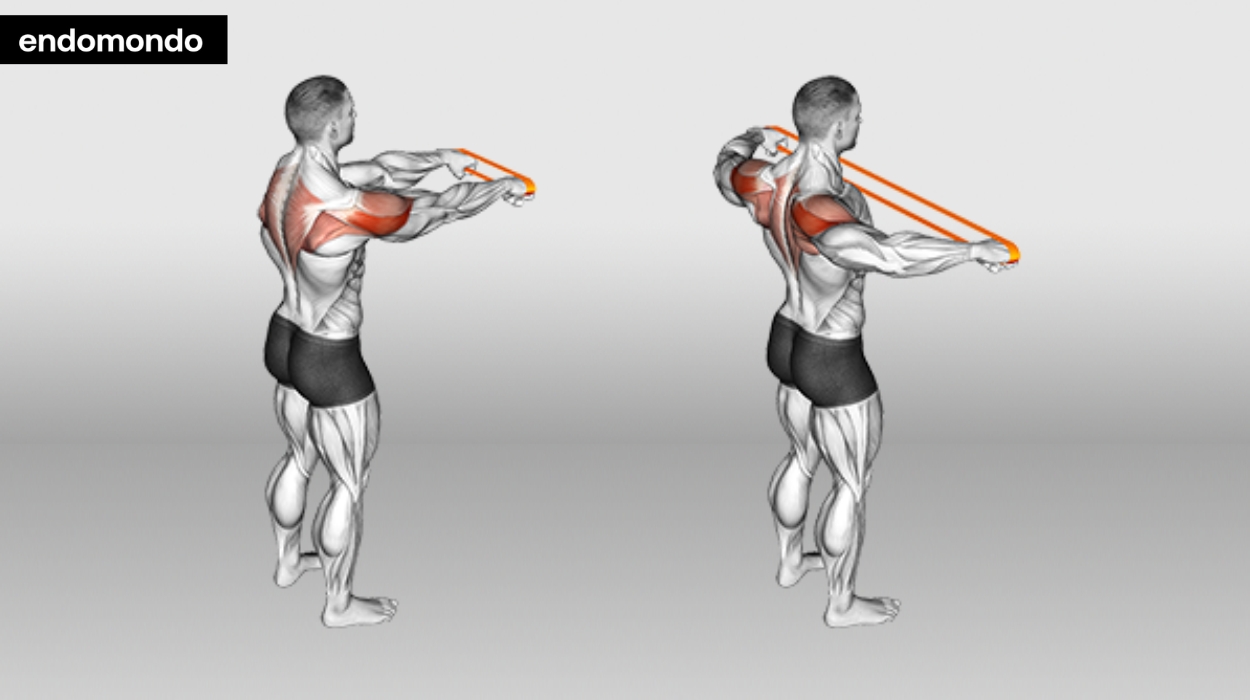
This is a shoulder workout that targets the upper back muscles. It also builds your upper body and posterior, or back, shoulder muscles using resistance bands.
It specifically targets the rhomboids[2] and posterior deltoid[3] muscles. These muscles are responsible for movements like bringing the shoulders back and extending the arms.
The benefits of this exercise include the following:
- Enhances the overall appearance and health of the shoulder.
- Improves posture because it strengthens the muscles and adjusts the position of the shoulder muscles to prevent rounded shoulders.
- Reduces the risk of injury and soreness since the well-built posterior deltoids stabilize the shoulder joint.
How to do:
- Stand with the resistance band beneath both feet while maintaining a hip-width distance.
- Keep your back straight and your core engaged while your hips are hinged forward and your knees are slightly bent.
- With your elbows slightly bent and your palms facing inwards and touching each other, hold the band ends.
- Pull the resistance band ends up and out as you squeeze your shoulder blades together. Pause when your arms are parallel to the floor.
- At the height of the contraction, maintain your posture for a few seconds before easing back into the initial posture.
- Repeat for the desired number of repetitions.
Tips:
- Maintain a straight back with your core engaged.
- Avoid swinging your arms. Instead, generate momentum by squeezing your back deltoids.
- Start with a band that enables you to move deliberately through 10 to 12 repetitions.
- Pay attention to how your muscles feel throughout the full range of motion.
- Exhale as you pull the band back and inhale as you lower it.
Optimal Sets And Reps: Aim for two to three sets of 10 to 12 repetitions using a comfortable resistance band.
Standing Dumbbell Lateral Raises
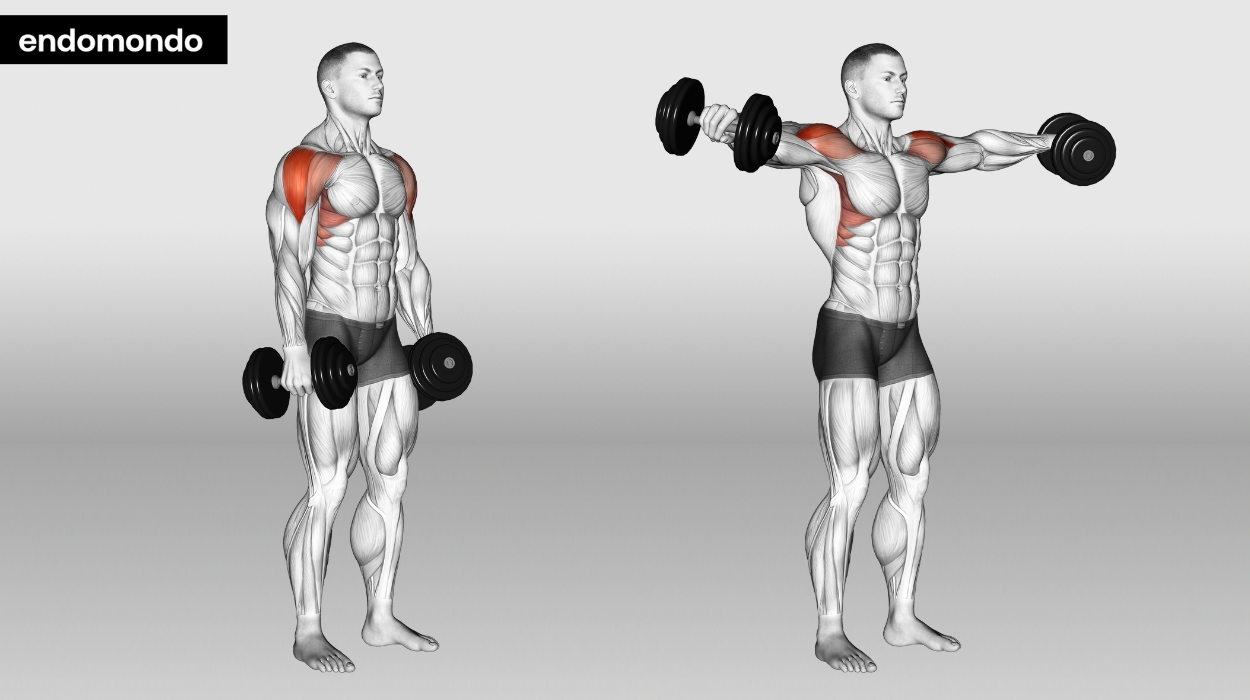
This shoulder workout entails raising a dumbbell with each hand laterally. It trains the medial, or middle deltoid,[4] the rotator cuff muscles, and the upper body muscles of the back.
The benefits of the standing dumbbell lateral raise span from improved aesthetics to functionality. They include the following:
- The isolation and strengthening of the medial deltoids, which play a major role in shoulder shape and definition.
- Improves athletic performance.
- Enhances calorie burning and muscle mass.
How to do:
- Place your feet shoulder-width apart, your back straight, and your core engaged.
- Hold a dumbbell in each hand with your arms relaxed by your sides and your palms facing inward.
- Raise your arms out to the sides while maintaining a slight bend in your elbows until your upper arms are parallel to the ground.
- Pause here for a moment, and squeeze your shoulder blades together.
- Return the dumbbells to their starting position slowly.
- Repeat this movement for the desired number of repetitions.
Tips:
- Maintain a straight back during the exercise and activate your core.
- Select dumbbells that will enable you to complete the workout in a controlled manner.
- As you lower the weights, ensure you inhale and exhale as you raise them.
- Perform dynamic and static stretches before and after the exercise to prevent injury.
Optimal Sets And Reps: While this ultimately depends on your fitness goals and level, performing the workout for two to three sets of eight to 12 repetitions should help achieve your goals.
Standing Dumbbell Front Raises
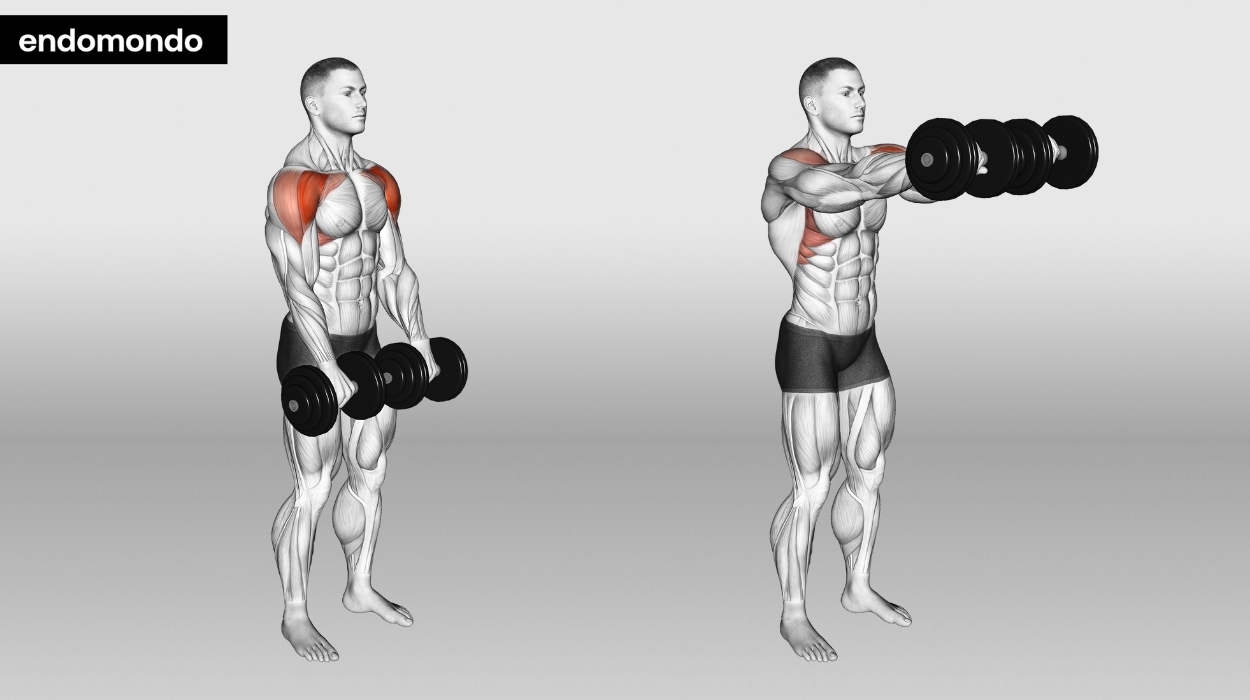
The standing dumbbell front raise is a shoulder exercise that primarily targets the anterior deltoid[5] or front shoulder. There is secondary engagement of the medial deltoid or side shoulder and upper trapezius, found on the upper back. Its benefits include the following:
- It builds and straightens the shoulder muscles.
- It improves shoulder stability and mobility.
- It improves posture.
How to do:
- Place your feet shoulder-width apart and tighten your core.
- Hold a dumbbell in each hand in a neutral grip, with your palms facing the front of your thighs.
- Raise the dumbbells vertically in front of you, keeping your elbows slightly bent until they are parallel to the ground or slightly higher if comfortable.
- Then, gradually reduce the dumbbells to the beginning position.
- Repeat the movement for the desired number of repetitions.
Tips:
- Remain centered and refrain from hunching over.
- Exhale as you raise the dumbbells and inhale as you lower them.
- Avoid using the dumbbells to swing.
- Focus on feeling the effect of the workout on your shoulders. Do not engage your lower back or neck.
- Stop the exercise if you experience any pain, and consult your healthcare professional immediately.
Optimal Sets And Reps: It depends on your fitness level and goals. However, two to three sets of eight to 12 repetitions should be optimal.
Standing EZ Bar Upright Rows
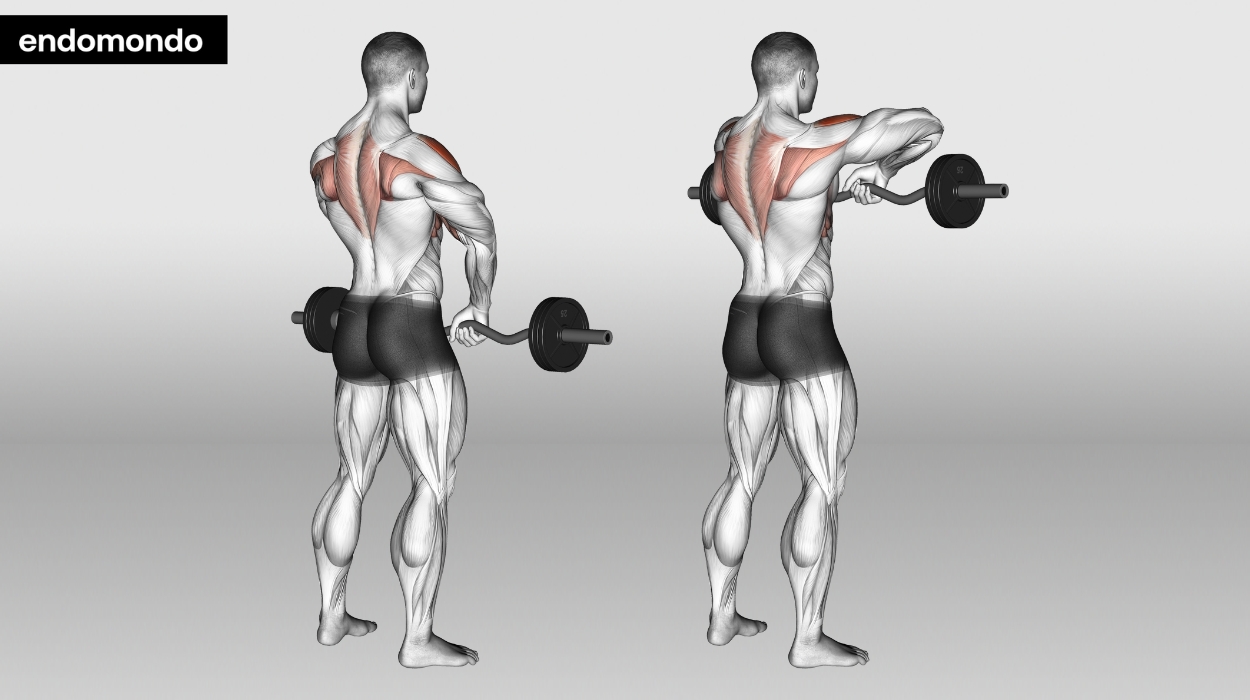
This exercise targets your shoulder muscles, primarily the anterior deltoids, with secondary engagement of the trapezius and biceps brachii. This shoulder and bicep workout involves using an EZ bar, a curved barbell that permits a smooth grip. The following are its benefits:
- It promotes wider and stronger shoulders since it targets the anterior deltoids while contributing to broader and well-sculpted shoulders.
- It improves overall strength and stability, which results from the upright row engagement of the upper body muscles.
- It leads to increased muscle mass and calorie burning.
How to do:
- Place your feet shoulder-width apart, and have your back straight and core engaged.
- Hold an EZ bar in a neutral grip with your arms relaxed by your sides and your palms facing your body.
- Bend your elbows, and raise the bar straight up to your chin, maintaining a close-to-body position and elbow height above your forearms the entire time.
- Squeeze your shoulder blades together until your upper arms are parallel to the floor.
- Return the bar to the beginning position by lowering it gradually.
- Repeat for the desired number of repetitions.
Tips:
- Keep your elbows close to your body, your back straight, and your core active.
- Choose a weight that allows you to maintain control and have proper form.
- Inhale as you lower and exhale as you raise the EZ bar.
Optimal Sets And Reps: Using a comfortable weight, two to three sets of eight to 12 reps should be optimal.
Seated Machine Lateral Raises
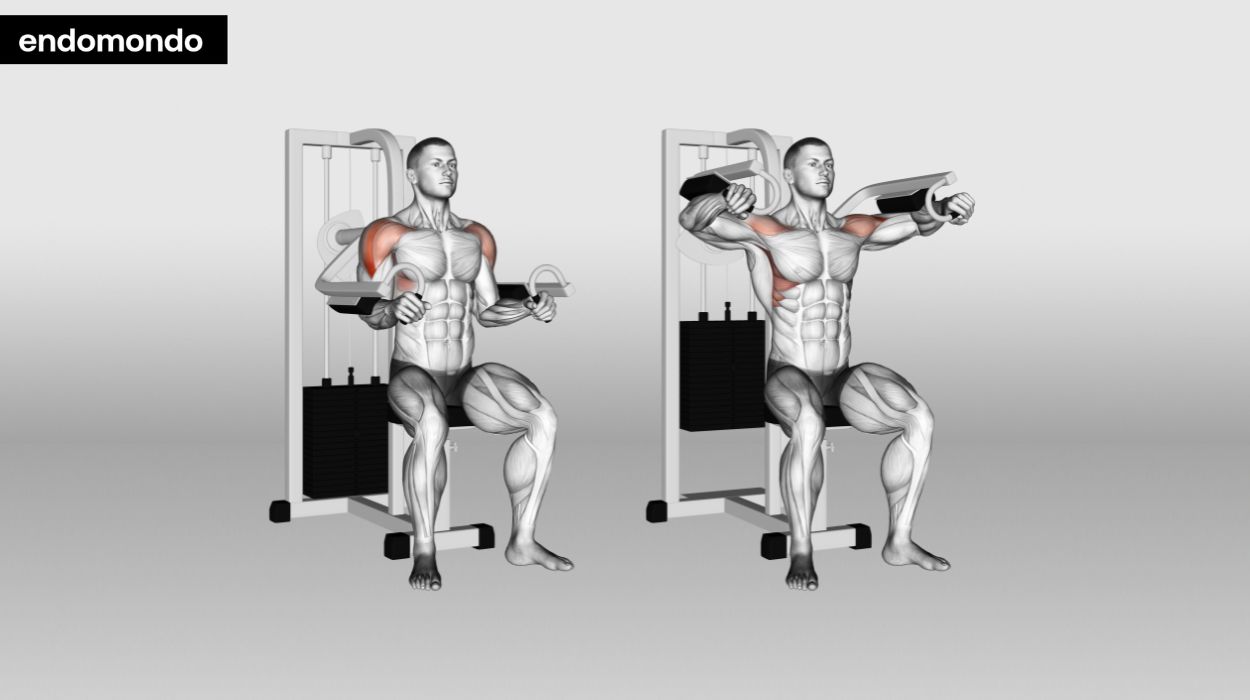
This overhead press substitute involves using a shoulder workout machine that isolates and strengthens the medial deltoids while working on the anterior deltoids, posterior deltoids, and core muscles.
Its simplicity makes it a versatile exercise that anyone can do, especially beginners and people who have shoulder injuries. The other benefits of this exercise include the following:
- It is a stabilized and controlled movement.
- It contributes to defined and balanced shoulder development.
- It improves muscle growth through constant tension.
- The engagement of the deltoid muscles is maximized.
How to do:
- Adjust the seat height of the machine so that your thighs are parallel to the ground. Take a seat on the machine.
- Position your elbows below your shoulder height and hold the handles with your palms facing each other.
- Exhale as you raise both arms up and away from your sides simultaneously.
- As your arms reach your shoulder height, inhale and bring them back to the initial position.
- Repeat this movement for the desired number of repetitions.
Tips:
- Ensure that you use your shoulder muscles to lift the weight and not the rest of your body.
- Keep your core engaged and your back straight throughout the exercise.
- Try different grip variations for more challenging attempts.
Optimal Sets And Reps: Aim for two to three sets of 12 to 15 reps.
Standing Plate Front Raises
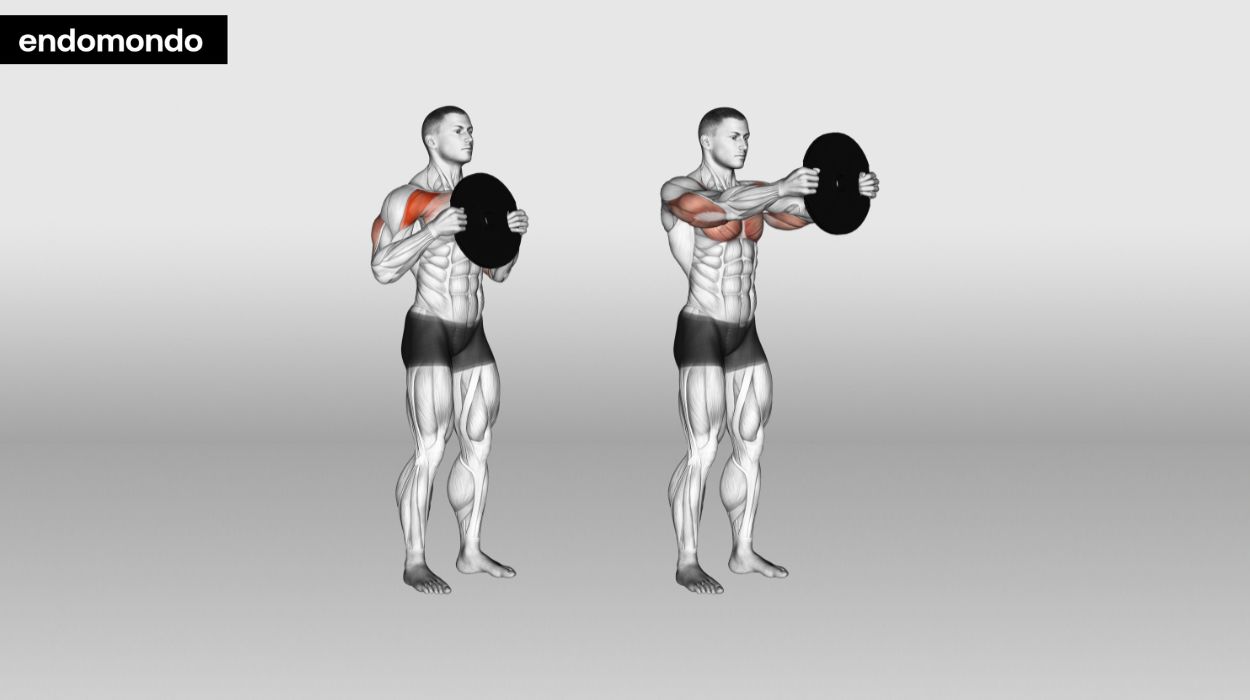
This shoulder workout is a twist that can provide you with a positive variation to your routine. Unlike other exercises, this entails holding a weight plate instead of a dumbbell or barbell to exercise your upper chest muscles and shoulders.
Specifically, this exercise targets the anterior deltoids. It builds strength and defines these muscles, giving them a well-developed aesthetic look. The benefits of this exercise include the following:
- It leads to increased strength in activities like throwing and pushing.
- It helps improve core stability and strength.
- It stimulates muscle growth of the front shoulders and upper chest muscles since it offers constant tension throughout the exercise.
How to do:
- Stand with your back straight, set your feet at shoulder width apart, and engage your core.
- Hold the weight plate with your hands positioned at 3 o’clock and 9 o’clock. Then, extend your arms in front of you and slightly bend your elbows.
- Maintain a slight elbow bend as you lift the plate upwards.
- Once the plate is at shoulder height, stay still for one to two seconds.
- Slowly lower the plate down to the starting position.
- Repeat for the desired number of repetitions.
Tips:
- Exhale as you lift the plate, and inhale as you bring it down slowly.
- Do not move or swing your body to generate momentum throughout the exercise. Focus on moving only with your front shoulder muscles.
- You can improve the intensity by changing the holding positions of the plate. For example, hold the plate with your thumbs facing up or with a neutral grip.
- You can decrease the intensity by sitting on a bench with a backrest.
- Do not start with heavy weights. It is more effective to start with lighter weights and increase the weight as you get stronger.
Optimal Sets And Reps: Try starting with three to four sets of eight to 12 repetitions with appropriate weights.
Standing Cable Rear Delt Flyes
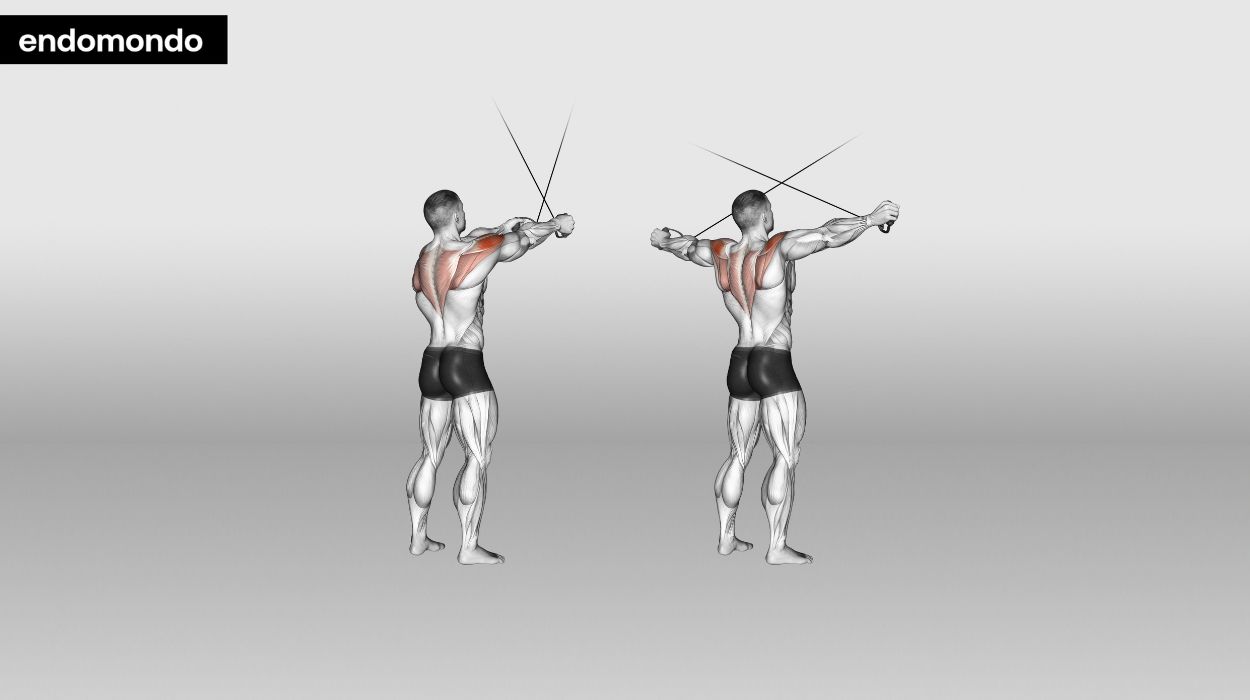
Standing cable rear delt flyes is a dynamic shoulder workout that builds and sculpts the upper back region while stabilizing and strengthening the shoulder. This exercise isolates the posterior deltoids, a major shoulder muscle that provides definition and stability.
It also works on the rotator cuff muscles[6] that stabilize the scapula and help to rotate the shoulder joint. The benefits of this exercise include the following:
- It improves upper back aesthetics.
- It enhances posture as the muscles chiefly responsible are well developed. This decreases pain and discomfort in several conditions.
- It improves core strength as the core muscles are actively involved throughout the exercise.
- It is adaptable to different muscle goals and plans by adjusting the cable weight and repetitions.
How to do:
- Stand facing a cable machine with your feet hip-width apart. There should be a handle attachment on either side positioned at shoulder height.
- Grab the right handle with your left hand and the left handle with your right hand.
- Engage your core and maintain a flat, neutral spine.
- Keep your arms slightly bent as you squeeze your upper back muscles and pull the left handle out to the right and the right handle out to the left. This should result in your arms being uncrossed.
- Hold the weight still at the peak of the extension for one to two seconds to feel the contraction at your posterior deltoid muscle.
- Maintain control and slowly return the weight to the starting position.
- Repeat for the desired number of repetitions.
Tips:
- Avoid swinging your body or creating any form of momentum with your body to lift the weight. Let the only movement be from your upper back and rear deltoid muscles.
- Keep your core engaged throughout the exercise.
- Keep your back straight and flat. Do not arch your back or lean forward throughout the exercise.
- Start with lighter weights and increase gradually as you get stronger.
- Pain is not a good sign. Therefore, do not push through the pain. Rather, stop and consult with a healthcare professional to investigate the issue.
Optimal Sets And Reps: Make sure you choose a weight that allows you to fulfill the technique correctly without inflicting injuries. The weights should be appropriate for eight to 12 repetitions. It is also optimal to aim for three to four sets per side.
Seated Dumbbell Arnold Press
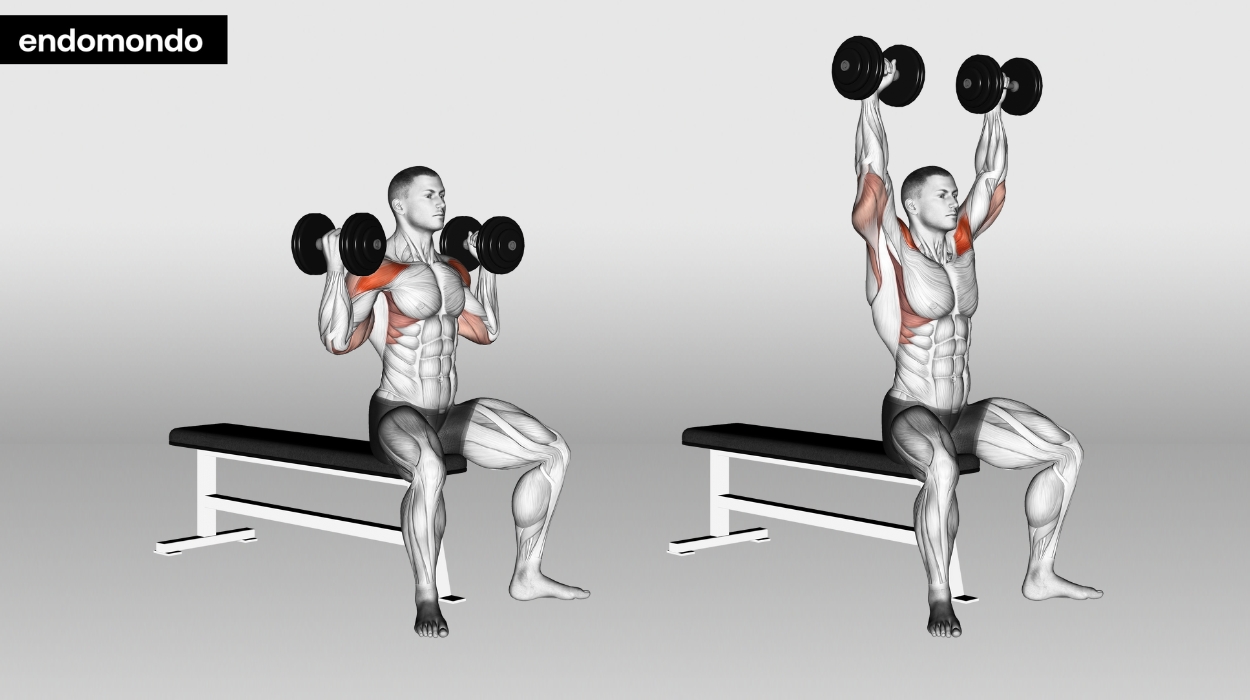
The seated dumbbell Arnold press exercise is among the effective shoulder workouts that help sculpt and strengthen your upper body. Specifically, it builds and sculpts the medial head of the deltoid muscle.[1] This is the rounded muscle on the side of your shoulder.
It also develops the lateral and posterior deltoid muscles, giving them a defined look. Additionally, it strengthens the core muscles.
However, there are several benefits of this dumbbell press beyond the aesthetics, and they include the following:
- It improves performance in other exercises and daily activities due to enhanced flexibility, improved range of motion, and stability of the shoulder joint.
- It improves core strength because maintaining a stable torso during the exercise strengthens the core muscles.
- This shoulder workout is versatile and people from experts and beginners can do it. You can adjust the weights, rest periods, and repetitions according to your goals.
How to do:
- Choose two dumbbells of appropriate weight and sit upright on a bench with a backrest, placing your feet flat on the floor.
- Grip the dumbbells firmly with your wrist facing inward and your palms facing your chest.
- Raise the dumbbells to shoulder height with your elbows bent at 90 degrees.
- Rotate your wrists to face forward while pushing the dumbbells up and above your head.
- Extend your arms to their maximum without locking your elbows.
- Slowly bring the dumbbells back to shoulder height while rotating your wrists to face your chest again. Maintain control in this step.
- Repeat the movement for the desired number of repetitions.
Tips:
- Exhale when pressing the dumbbells above shoulder height and inhale when returning them down.
- Prioritize utilizing the proper technique over lifting heavy weights. Starting with lighter dumbbells and increasing weight over time will reduce the risk of injury.
- Maintain a straight back throughout the exercise. Avoid arching back or leaning forward.
- Keep your core tightened throughout the exercise.
- Perform warm-up exercises before attempting this exercise.
Optimal Sets And Reps: Aim for three to four sets of 10 to 12 reps.
Standing Kettlebell Swings
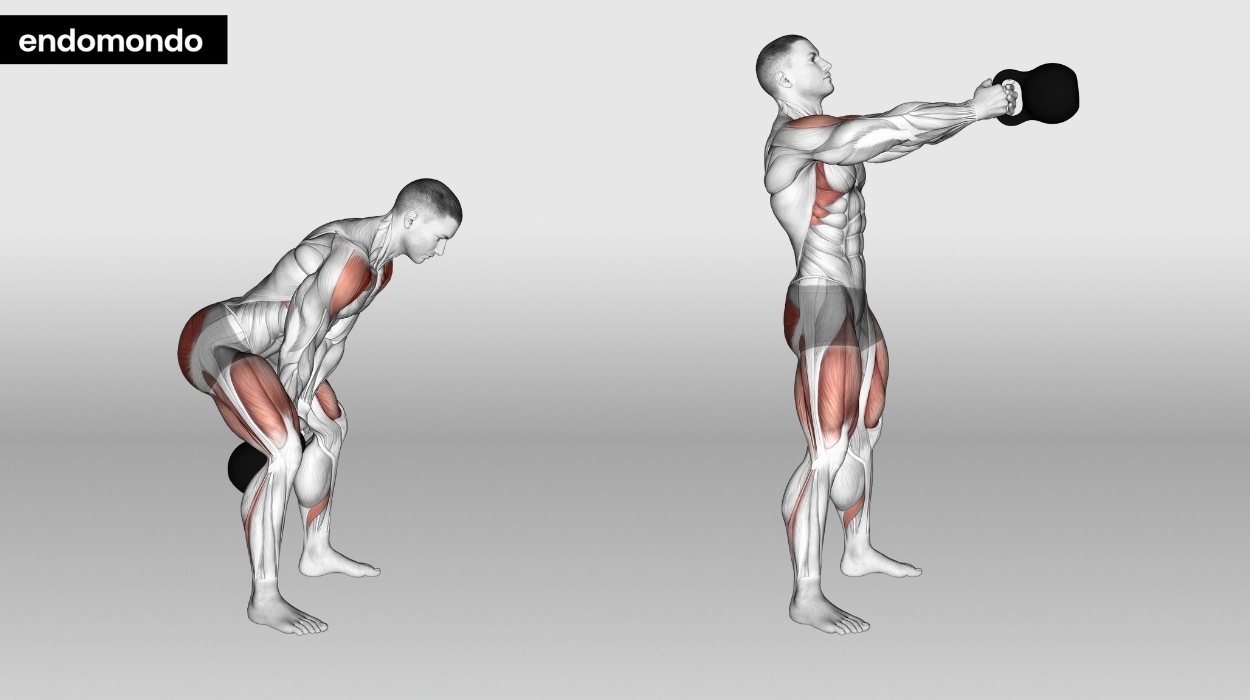
Standing kettlebell swings are an active, full-body workout that works on several muscles but mainly targets your glutes and hamstrings. It also engages your core, back, shoulders, and cardiovascular system.
The benefits of this exercise include the following:
- The dynamic steps involved in kettlebell swings are similar to the traditional weightlifting exercises and imitate daily lifting activities but with a thrust add-on.
- The basic steps of kettlebell swings are done using the shoulder muscles, especially the rotator cuff and back muscles. Training these muscles will help prevent shoulder injury and improve grip strength.
- It combines strength training and cardio.
How to do:
- Choose an appropriate kettlebell weight and place it between your ankles.
- Start by standing with your ankles hip-width apart and your toes slightly pointed out.
- Keep a straight and flat back, bend at your hips while pushing out your buttocks, and reach for the handle of the kettlebell with your palms facing you and firmly grip the handle.
- Push out your hips and buttocks further, keep your knees slightly bent, and swing the kettlebell back between your ankles.
- Keep your back straight, engage your core, and drive your hips forward to pull the kettlebell to shoulder height. Come to standing and keep your arms straight throughout the swinging motion.
- Maintain your core strength and let momentum push down the kettlebell naturally between your legs again.
- Repeat for the desired number of repetitions.
Tips:
- Start with light weights and focus on getting the technique right rather than carrying heavier weights, which have risks of injuries.
- Keep your core tightened and your back straight throughout the exercise for stability.
- Focus on using your arms to pull the kettlebell up. This will better engage your arms.
- Take a deep breath before the initial downward swing and exhale as it swings towards the shoulder height.
- Stop the workout if you feel pain and get help from a healthcare professional.
Optimal Sets And Reps: Performing three to five sets of 10 to 20 repetitions should be optimal.
What Makes An Effective Overhead Press Alternative?
Although the effectiveness of an alternative for overhead press depends on your fitness level and objectives, a decent overhead press substitute should have the following important characteristics.
Targeted Muscle Groups
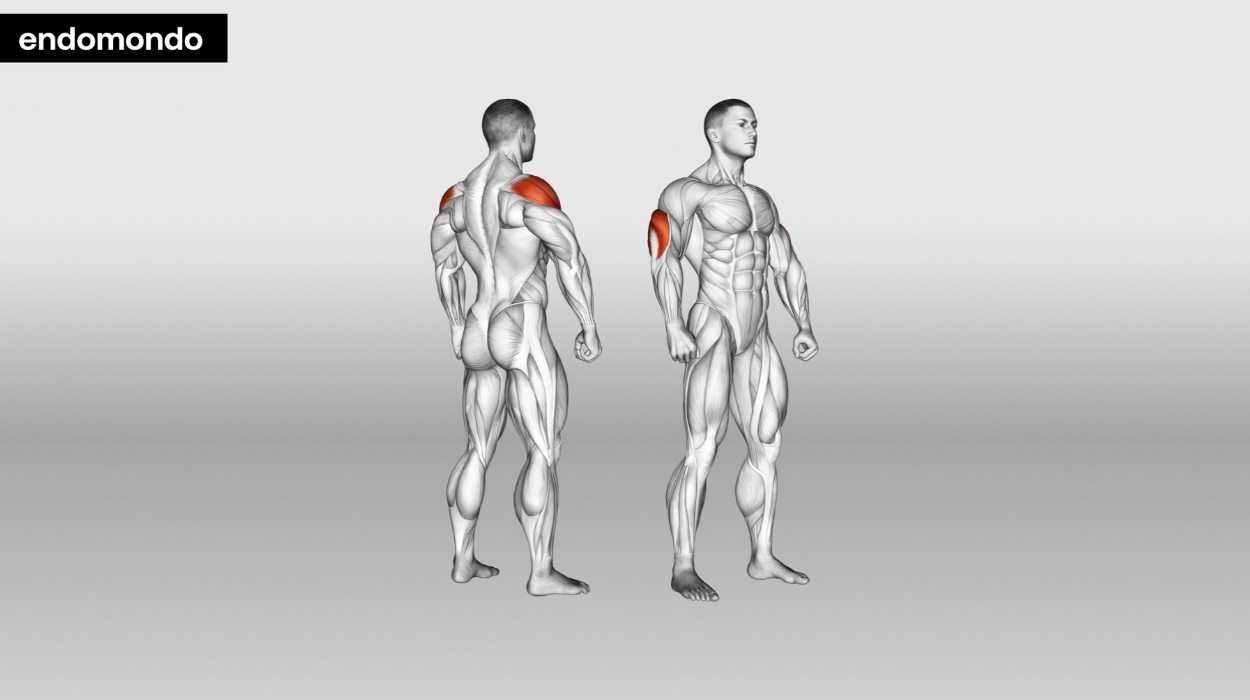
An alternative for overhead press must specifically target muscle groups such as the deltoids, triceps, and core. This guarantees that you build strength or muscle mass in the appropriate regions.
Some workouts might target particular deltoid heads more than others. For example, the Arnold press specifically works more on the medial deltoid compared to the regular overhead press.
Pattern Of Movement
Overhead press substitutes are done in movement patterns that are specific to train the targeted muscle group. An excellent example is the vertical pushing action or vertical pressing. To continue effectively targeting the specific muscles, alternative exercises will involve the same pattern of movement.
Security And Availability
Every exercise must be safe to perform, and the appropriate pieces of equipment must be available. If you already have problems with your shoulders, it would be best to choose an alternative that will not make them worse.
Reasons For Doing Overhead Press Alternatives
Although the overhead press is one of the ideal methods for developing strong, defined shoulders, other effective options are available. The following are some of the reasons people adopt the various alternatives.
Pain Or Injury
When performing regular overhead presses, it is possible to develop shoulder soreness or pain. At this point, it is advisable to examine the cause of it and switch workouts to an alternative if needed.
Different motions can work the same muscle groups with less strain on delicate regions. Examples include landmine presses with angled presses and dumbbell presses with a more neutral grip. The single-arm landmine press involves pushing the end of a barbell overhead in a similar motion as a dumbbell overhead press.
Restrictions On Mobility
Problems with overhead mobility can make it challenging to execute regular overhead presses, such as overhead barbell press, safely and with good technique. Therefore, alternatives with a smaller range of motion, such as incline dumbbells or Arnold presses, may be helpful in such situations.
Focusing On Particular Muscle Groups
The anterior head, or front deltoids, are the primary focus of the overhead press. Even while this is the best approach for developing your shoulders generally, you may prefer to focus on other areas. Hence, you could adopt alternatives like the rear delt flyes, which target the posterior deltoids, or lateral raises, which concentrate on the medial deltoids.
Conclusion
As seen above, several overhead press variations exist. They offer dynamic and exciting options to train your shoulders in 2024. So, you should choose exercises that suit your fitness goals perfectly and work with the right techniques.
More importantly, shoulder workouts should not be confined to gyms. Many of these exercises need minimal equipment that gives the liberty to train and sculpt your body, even at home.
But whether you prefer the gym or performing shoulder workouts at home, try to implement these alternatives to your routine.
Frequently Asked Questions
A Smith machine shoulder press is a popular alternative to an overhead press. It specifically targets the deltoid muscles. A machine shoulder press does not require excess movements, thus protecting the shoulder from injury.
Yes. Dumbbell presses can replace overhead presses as they are more versatile and easier to control. This is mostly done when there is pain while using an overhead press and in those with low grip or forearm strength.
You can do so by performing exercises that can help you get bigger shoulders. They include the push press, Arnold dumbbell press, lateral plank walks, any pull-up alternative, and a barbell shoulder workout.
In cases of a shoulder injury, some exercises can replace the overhead press. These include handstand push-ups, Arnold press, dumbbell external rotation, dumbbell shoulder press, landmine press, and single arm resistance band press.
Resources
- Adel Elzanie and Varacallo, M. (2024). Anatomy, Shoulder and Upper Limb, Deltoid Muscle. [online] Nih.gov. Available at: https://www.ncbi.nlm.nih.gov/books/NBK537056/.
- Cowan, P.T., Mudreac, A. and Varacallo, M. (2023). Anatomy, Back, Scapula. [online] Nih.gov. Available at: https://www.ncbi.nlm.nih.gov/books/NBK531475/.
- Javed, O., Maldonado, K.A. and Ashmyan, R. (2023). Anatomy, Shoulder and Upper Limb, Muscles. [online] Nih.gov. Available at: https://www.ncbi.nlm.nih.gov/books/NBK482410/.
- Yuri, Vianna, J.M., Guimarães, M.P., Jorge, Hernández-Mosqueira, C., Silva and Marchetti, P.H. (2020). Different Shoulder Exercises Affect the Activation of Deltoid Portions in Resistance-Trained Individuals. Journal of Human Kinetics, [online] 75(1), pp.5–14. doi:https://doi.org/10.2478/hukin-2020-0033.
- Coratella, G., Tornatore, G., Longo, S., Esposito, F. and Emiliano Cè (2020). An Electromyographic Analysis of Lateral Raise Variations and Frontal Raise in Competitive Bodybuilders. International Journal of Environmental Research and Public Health, [online] 17(17), pp.6015–6015. doi:https://doi.org/10.3390/ijerph17176015.
- Smita Maruvada, Madrazo-Ibarra, A. and Varacallo, M. (2023). Anatomy, Rotator Cuff. [online] Nih.gov. Available at: https://www.ncbi.nlm.nih.gov/books/NBK441844/.




